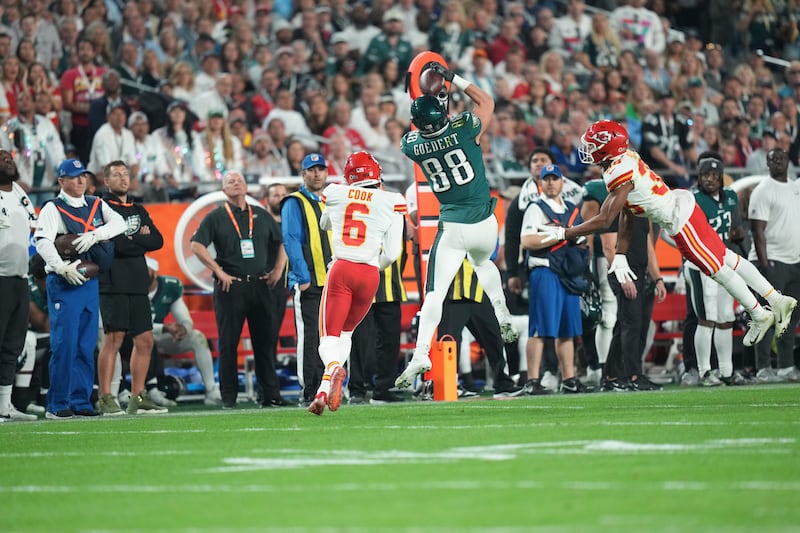The pattern only became clear when it was pointed out to me on Monday morning. But what the hell had we spent our entire time watching last weekend?
Ireland against France had been a genuinely thrilling game, one of the very best Six Nations games in recent memory. But an inordinate amount of time in what had otherwise been a sensational first half had been given over to two decisions over which the referee, his touch judges, and his television match official had deliberated.
They deliberated for an age, and they got both decisions wrong. One was Uini Atonio’s red card hit on Rob Herring, which was somehow deemed to be only a yellow card, and the other was James Lowe’s try, when even the player himself seemed acutely aware that his foot had been in touch.
We will leave aside the fact that the referee and the TMO seemed not to have seen the most incriminating angle, the one from behind Lowe, which proved conclusively that his toe was in touch (someone, somewhere should be asking serious questions about how this happened.)
The fact was – both calls were wrong. They were looked at from a variety of angles, in slow motion and with no time limit on how long they could deliberate on them, and the humans involved still got them wrong.
As is often the case on Six Nations weekends, the day’s Premier League action can be thoroughly overshadowed. So I knew refreshingly little about how the day’s games had gone when I sat down to watch Match of the Day on Saturday evening.
There was a horrendous offside decision that was just plain missed by the officials in the Arsenal/Brentford game, a game that could have major repercussions for the title this year. There was an obvious handball against Chelsea in the closing minutes of their game against West Ham on Saturday morning, and a farcical offside given against Brighton, where the humans involved in VAR drew the offside line off the wrong player.

Fast-forward to Sunday evening, and the Super Bowl – often the only game of the NFL season that many people will watch. There was a disputed catch, reviewed by TMO officials, by Dallas Goedert of the Philadelphia Eagles in the second half of that game that led those in the broadcast booth to proclaim, almost in one voice, “I don’t know when a catch is even a catch any more”. The whole of Ireland, or at least that part of Ireland still up after 2am, would have been forgiven for saying – well if you don’t know lads, what chance in hell do we have?
My soccer team of choice, Manchester United, are currently trying to insert themselves into the title race. Earlier on Sunday, Marcus Rashford put them 1-0 up in the final quarter of their match against Leeds. He raced off in celebration, but I waited patiently for the inevitable VAR intervention that would crush my dreams and leave my wife laughing at me again. By the time the goal was confirmed and given, the moment had passed.
Is this really adding anything to our enjoyment of sport? Last weekend was proof that it gives no protection whatsoever from human error. All it does is delay games interminably, as well as rob the spectator of the moments of spontaneous joy that are basically the reason we show up every weekend for this nonsense.
And yet there will still be people who will insist the GAA is missing a trick by not embracing technology. They will trot out lines like “it will fix the egregious error, or the blatantly obvious” – as if there is a clearly defined line between the egregious, the blatantly obvious, and the debatable.
GAA referees are going through a challenging period at the moment, and there is a belief out there that this would take some of the pressure off them. All video evidence would do is remove whatever protection they now have, which is that they have to make a decision in real time. If they have multiple chances to watch an incident back, and still get it wrong, they don’t even have that defence.
The only current help that referees get from technology is from Hawk-Eye, in selected grounds. The All-Ireland football semi-final between Galway and Derry saw a clear point from Shane Walsh over-ruled by technology, only to be reinserted at half-time, once the whole world had seen it was clearly over the bar.
So even the technology isn’t infallible. I’m still broadly in favour of Hawk-Eye, as it’s pretty quick (when it’s working), and it adjudicates only in moments when even fans in the ground and in the stands aren’t sure if it’s gone over. In those situations, no one starts celebrating wildly, only to be told – Sir, please put your shirt back on, this score is about to be disallowed.
For all other decisions, television will be more trouble than it’s worth, and what you lose will be far greater than what you’d gain. Hurling and Gaelic football are two games without a clearly defined tackle. Does anyone really think TV replays are going to make them any easier to define?

















